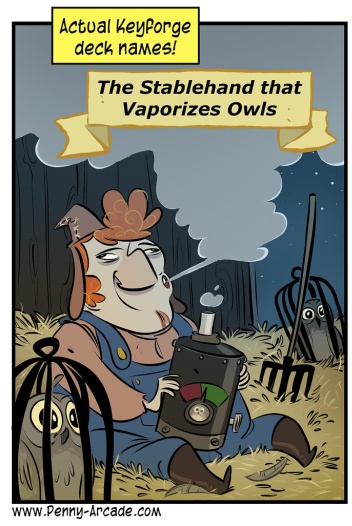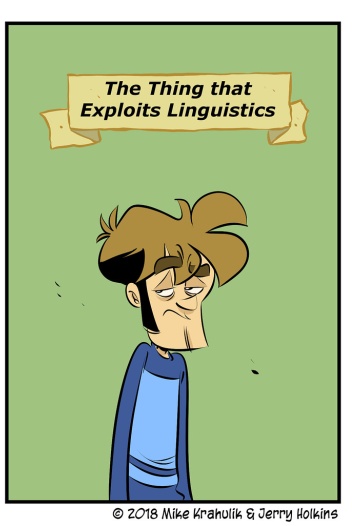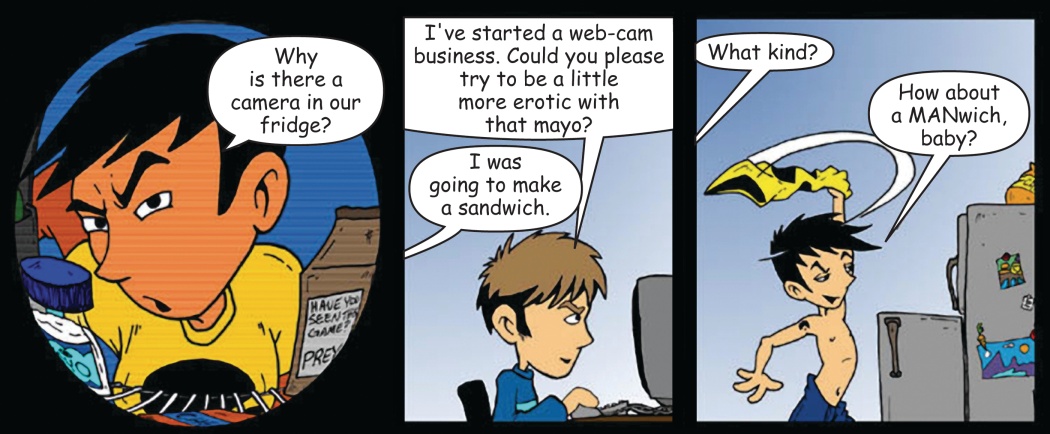The cards in a given Keyforge deck are pulled from the whole set, and the names are generated by some kind of computerized madness. Occasionally it's lead to some, uh… Hm. There's a standing offer by multiple retailers I know where they just replace your deck if it turns out to be named in an incredibly offensive way, but if I were them I woulda been much more careful with my corpus. Most names are just goofy though and I suspect we could make comics like today's for quite a while and still find it amusing.
I've been carding the fuck out the last month or so and it shows no sign of slowing. I want to talk about Thronebreaker for example, and go into why Warhammer Champions is like winding an evil clock, but I'll have to save those for later. Keyforge was the Thing at the show and I've been meaning to get to it so we'll start there. I said that it was the third part of a coherent Richard Garfield trilogy, and this is what I meant by that:
Magic: The Gathering is about making the most successful deck you can from an evolving superset.
Netrunner has this too, but two distinct supersets are competing against each other asymmetrically. This is what makes it a conceptual sequel, in my opinion: this cleaving into two distinct wholes.
Keyforge is the opposite of both. It is about making the best of what you have.
Now, you can say that the final entry in this trilogy is a "down note," which often happens in narratives, but it's an inversion of the premise. In a way, it's a kind of statement about Magic and CCGs as a concept. It's deeply heretical in ways that make it hard to explain to people who love the form: there's no health. There's no mana. There's no deckbuilding, and there's no boosters.
I fielded a few questions online about Keyforge, and one of the odd things about the game in general is that it is designed as an answer to the questions you'd ask. You can't really think about it like a CCG. Personally, I think you should play it like a boardgame: get five or six decks and play them against each other, and you're done. There's a concept called Chains which are designed to weigh down superior decks through draw restrictions; they're also used to bid for powerful decks. Some decks are better than others, and this is meant to ameliorate that. Sportsmanship is a virtue here.
I used to play the World of Warcraft TCG, maybe as hard as I've ever played collectible card game, and one thing they really pioneered was the Boss Decks: classic raids distilled into monstrous, unfair, cooperative encounters. I was obsessed with that shit, we did comics and everything. I don't think that concept was really given its due again until White Wizard's efforts in Hero Realms. Anyhow, one of the things that made the concept so compelling is that there's a lot of cards that don't make sense in a lean, brutal deck you'd use for PvP. But now, against this new foe, you're parsing cards in a completely different way - you can even specialize decks to do things like Main Heal. You're using cards you never would have given a second look.
You want to play Keyforge as optimally as possible, but you do so within the bounds of your deck. You're trying to generate a resource called Ember, but of course it's like Ember that starts with that "ae" thing because their parents didn't love them or something. You need six of these to "forge a key," and you need to forge three keys to win. So much of the game is like Tug O' War or Keep Away, trying to grab or even just hold the opponent's Ember away from them long enough for you to get your keys done. Every deck you buy is made up of cards from three different Houses, and when your turn comes around you choose one of them and play all the cards you want from that House. So there's no mana, but there's a sensible - yet gameable - limitation on what you can accomplish because you can only do things with a particular house at a time. Obviously, there's a couple keywords that let you muddy the waters a bit but generally that's how you comport yourself. In this way, it's a race to get keys built, and it feels like it. Cards and creatures operate traditionally, they have strength or whatever, but most of their interactions are about Ember and they can't attack the player. So, even if they look the same they do other things - for example, often the smaretest move isn't to attack enemy creatures at all but to "Reap" - that is to say, Generate Ember. They can all do it. You want to kill troublesome, multicard Engines but you are not here to wage war. You have a more glorious purpose.
Tournament-wise at PAX Unplugged, there were a few formats on-hand: some where you bring decks from home, some the Keyforge equivalent of "Sealed Deck," where you pop open a couple decks and now you're ready to play. I think the latter is much more Keyforge, frankly - more harmonious with the thesis: this is what we got. This is where we're at. And we succeed by making the best of it.
(CW)TB out.



